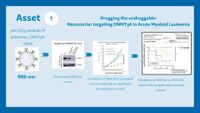Treatment of Acute Myeloid Leukemia (AML) using siRNA nanocarriers
Acute myeloid leukemias (AML) are malignant diseases of the hematopoietic system, which are characterized by an uncontrolled accumulation of immature progenitor blood cells, the so-called blasts, in the bone marrow.
Recently, mutations in the methylating enzyme DNA methyltransferase 3A (DNMT3A) have been found in up to 20–30% of all AML patients. These mutations can even be detected in early bone marrow cells before leukemia develops. Thus, one can postulate that mutated DNMT3A paves the way to leukemia and is essential for the development of leukemia. Our working group has developed a system with which these siRNAs are bound to a protamine-nanocarrier that is decorated with the leukemia cell-specific anti-CD33 antibody so that the siRNAs are specifically transported to the leukemia cell in vivo and can be internalised into the cell protected from degradation. We found that inhibition of DNMT3A via antibody-siRNA nanocarriers leads to reduced growth and increased cell death of leukemic tumor cells in vitro and in vivo in mouse models, indicating a therapeutic effect on the leukemia cells.
Asset 1: Treatment of Acute Myeloid Leukemia (AML) using siRNA nanocarriers
Medical need: Acute Leukemias are malignant diseases of the hematopoietic system, which are characterized by an uncontrolled accumulation of immature progenitor blood cells, the so-called blasts, in the bone marrow of mainly elderly people. With the rising life expectancy worldwide, AML development depicts an increasing risk in aging communities. Since almost half a century, the therapy was dominated by one intense chemotherapy regimen (the 7+3, being a combination of daunorubicin and cytarabin), while the AML survival improved predominantly by a better supportive care and the introduction of stem cell transplantations. So there is an intense need for better therapies.
Mutations in the methylating enzyme DNA methyltransferase 3A (DNMT3A) have been found in up to 20–30% of all AML patients. These mutations can even be detected in early bone marrow cells long before leukemia develops. We postulate that mutated DNMT3A paves the way to leukemia and is essential for the development of leukemia. But there is no drug against the effect of mutated DNMT3a.
Drugging the undruggables: Our working group has developed a system, with which siRNAs inactivating DNMT3a are bound to a protamine-nanocarrier BBB-001 that is decorated with the leukemia cell-specific anti-CD33 antibody. This way, the siRNAs are specifically transported to the leukemia cell in vivo and can be internalised into the cell protected from degradation. We found that inhibition of DNMT3A via antibody-siRNA nanocarriers leads to a markedly reduced growth and increased cell death of leukemic tumor cells in vitro and in vivo in mouse models, indicating a therapeutic effect on the leukemia cells.

